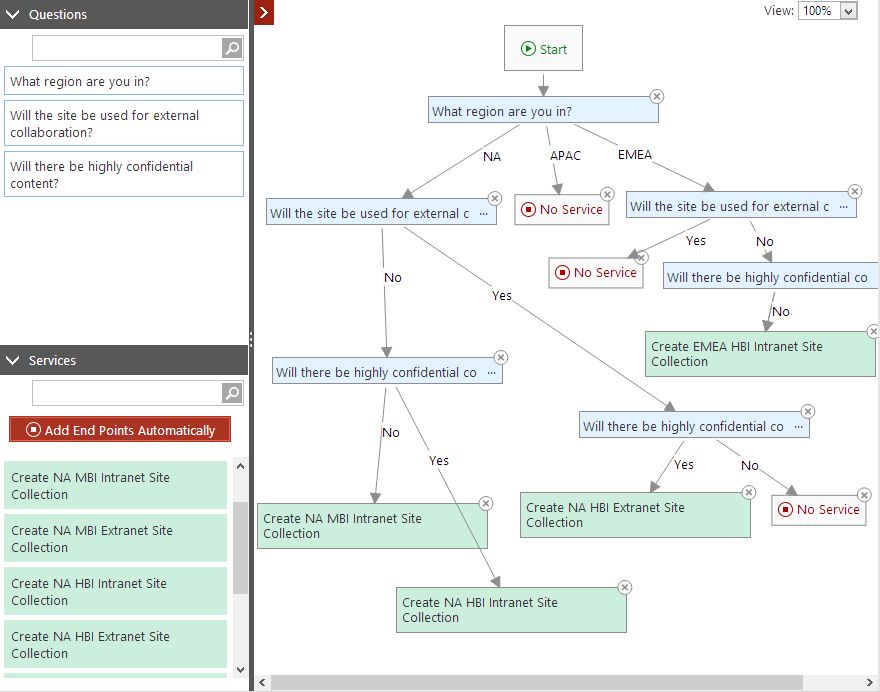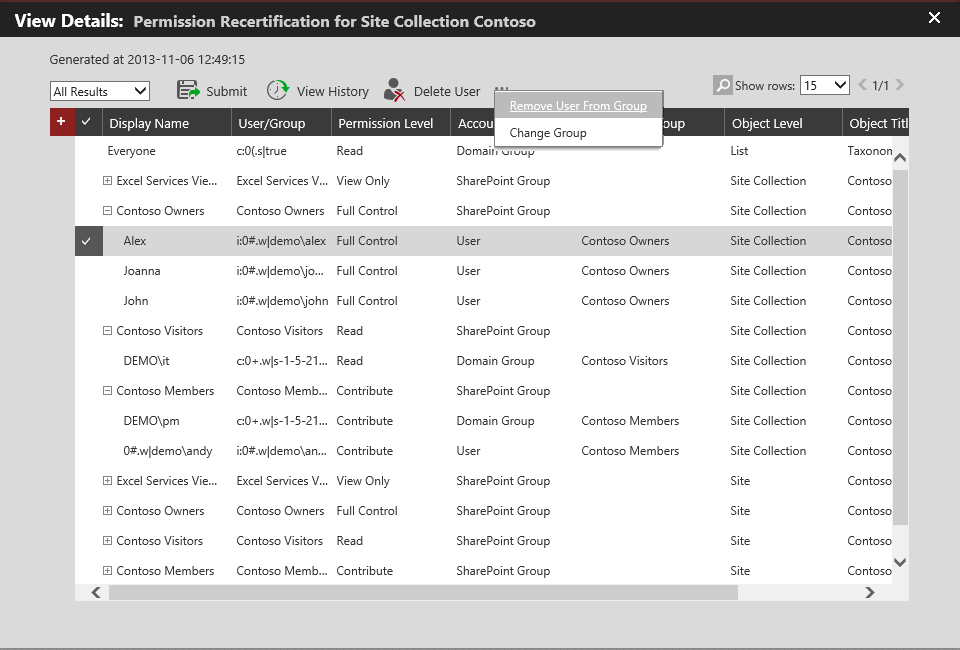 Figure 1. An example of a questionnaire logic flow diagram in DocAve Governance Automation SP 4. 3. Security recertification: Many organizations have security audit policies that require periodic reviews of user access rights in SharePoint. It is the responsibility of the site collection owner to review and certify that all user permissions on their site collection are in compliance with the organization’s security policy. Governance Automation enforces accountability for this business process by automatically assigning a task to the responsible site collection business owner to review the security report on a scheduled interval per organizational governance policy. If any user permissions require change, actions can be taken directly through the report. Active Directory (AD) group permissions can be expanded to show group membership details. All permissions changes by all users involved in the recertification process are tracked and historical versions are recorded to ensure accountability and traceability.
Figure 1. An example of a questionnaire logic flow diagram in DocAve Governance Automation SP 4. 3. Security recertification: Many organizations have security audit policies that require periodic reviews of user access rights in SharePoint. It is the responsibility of the site collection owner to review and certify that all user permissions on their site collection are in compliance with the organization’s security policy. Governance Automation enforces accountability for this business process by automatically assigning a task to the responsible site collection business owner to review the security report on a scheduled interval per organizational governance policy. If any user permissions require change, actions can be taken directly through the report. Active Directory (AD) group permissions can be expanded to show group membership details. All permissions changes by all users involved in the recertification process are tracked and historical versions are recorded to ensure accountability and traceability.  Figure 2. Permissions recertification screen in DocAve Governance Automation SP 4 listing all users and groups that have access to the site collection with options to modify permissions. 4. Grant temporary permissions: In DocAve 6 SP 3, we introduced a powerful feature in DocAve Administrator that enables administrators to grant user permissions on a temporary basis. This helps with the management of temporary workforce by allowing administrators to schedule permission expiration dates in advance based on the work contract period. Upon expiration, the permissions will be automatically revoked. In DocAve Governance Automation SP 4, we empower business users to submit requests for temporary permissions with an approval process.
Figure 2. Permissions recertification screen in DocAve Governance Automation SP 4 listing all users and groups that have access to the site collection with options to modify permissions. 4. Grant temporary permissions: In DocAve 6 SP 3, we introduced a powerful feature in DocAve Administrator that enables administrators to grant user permissions on a temporary basis. This helps with the management of temporary workforce by allowing administrators to schedule permission expiration dates in advance based on the work contract period. Upon expiration, the permissions will be automatically revoked. In DocAve Governance Automation SP 4, we empower business users to submit requests for temporary permissions with an approval process.  Figure 3. Settings for temporary permissions on the permissions request form in DocAve Governance Automation SP 4. 5. Policy Enforcer integration: Policy Enforcer was another key new feature in DocAve Administrator in DocAve 6 SP 3. Whereas Governance Automation proactively enforces governance policies and rules and ensures that SharePoint content is provisioned within governance boundaries, Policy Enforcer ensures all sites remain within policy and under control by monitoring sites around the clock, automatically adjusting settings and configurations across existing environments. As an example to show how the products integrate: Suppose your governance policy stipulates that all document libraries must have versioning turned on. With DocAve Governance Automation, you can enforce that all new document libraries requested by users have versioning turned on. However, if a user created a new document library directly in SharePoint without turning versioning on, this is where Policy Enforcer comes to the rescue. Policy Enforcer comes out-of-the-box with the rule to enforce library or list-level versioning. The site collection provisioning process in Governance Automation SP 4 enables a Policy Enforcer profile and its associated rules to be automatically applied, providing not only proactive governance but also continual monitoring and control for that site collection content. To read about the features offered through previous service pack updates, please visit the following blog posts: · SP 1 · SP 2 · SP 3 For more information, videos, and screenshot tour of DocAve Governance Automation, please visit our product page. To try it for yourself, download a free trial today!
Figure 3. Settings for temporary permissions on the permissions request form in DocAve Governance Automation SP 4. 5. Policy Enforcer integration: Policy Enforcer was another key new feature in DocAve Administrator in DocAve 6 SP 3. Whereas Governance Automation proactively enforces governance policies and rules and ensures that SharePoint content is provisioned within governance boundaries, Policy Enforcer ensures all sites remain within policy and under control by monitoring sites around the clock, automatically adjusting settings and configurations across existing environments. As an example to show how the products integrate: Suppose your governance policy stipulates that all document libraries must have versioning turned on. With DocAve Governance Automation, you can enforce that all new document libraries requested by users have versioning turned on. However, if a user created a new document library directly in SharePoint without turning versioning on, this is where Policy Enforcer comes to the rescue. Policy Enforcer comes out-of-the-box with the rule to enforce library or list-level versioning. The site collection provisioning process in Governance Automation SP 4 enables a Policy Enforcer profile and its associated rules to be automatically applied, providing not only proactive governance but also continual monitoring and control for that site collection content. To read about the features offered through previous service pack updates, please visit the following blog posts: · SP 1 · SP 2 · SP 3 For more information, videos, and screenshot tour of DocAve Governance Automation, please visit our product page. To try it for yourself, download a free trial today!
